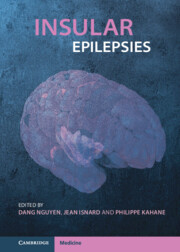Book contents
- Insular Epilepsies
- Insular Epilepsies
- Copyright page
- Contents
- Contributors
- Foreword
- Chapter 1 A Brief History of Insular Cortex Epilepsy
- Section 1 The Human Insula from an Epileptological Standpoint
- Section 2 The Spectrum of Epilepsies Involving the Insula
- Section 3 Noninvasive Investigation of Insular Epilepsy
- Section 4 Invasive Investigation of Insular Epilepsy
- Chapter 17 Invasive Investigation of Insular Epilepsy: Indications and Preplanning
- Chapter 18 Invasive Investigation of Insular Epilepsy: Surgical Techniques
- Chapter 19 Qualitative Interpretation of Intracranial EEG in Insular Epilepsy
- Chapter 20 Quantitative Intracranial EEG Signal Analysis in Insular Epilepsy
- Chapter 21 Electrical Stimulation of the Human Insular Cortex
- Section 5 Surgical Management of Insular Epilepsy
- Index
- References
Chapter 18 - Invasive Investigation of Insular Epilepsy: Surgical Techniques
from Section 4 - Invasive Investigation of Insular Epilepsy
Published online by Cambridge University Press: 09 June 2022
- Insular Epilepsies
- Insular Epilepsies
- Copyright page
- Contents
- Contributors
- Foreword
- Chapter 1 A Brief History of Insular Cortex Epilepsy
- Section 1 The Human Insula from an Epileptological Standpoint
- Section 2 The Spectrum of Epilepsies Involving the Insula
- Section 3 Noninvasive Investigation of Insular Epilepsy
- Section 4 Invasive Investigation of Insular Epilepsy
- Chapter 17 Invasive Investigation of Insular Epilepsy: Indications and Preplanning
- Chapter 18 Invasive Investigation of Insular Epilepsy: Surgical Techniques
- Chapter 19 Qualitative Interpretation of Intracranial EEG in Insular Epilepsy
- Chapter 20 Quantitative Intracranial EEG Signal Analysis in Insular Epilepsy
- Chapter 21 Electrical Stimulation of the Human Insular Cortex
- Section 5 Surgical Management of Insular Epilepsy
- Index
- References
Summary
Approximately 70% of patients with insular epilepsy require invasive investigation prior to resective or ablative surgery. Two broad techniques can be employed to invasively sample the insula and insular epileptogenic network. The first and most commonly used technique, stereo-electroencephalography (SEEG), involves the placement of intracerebral electrodes through drill-holes under stereotactic conditions (with or without robotic assistance) in the insula and relevant peri-insular network targets. The open technique involves the placement of depth electrodes within the insular cortex following the opening of the Sylvian fissure, in addition to peri-Sylvian grids over the cortical convexities or strips over the fronto-temporal-basal lobes/interhemispheric space. While there are no guidelines to decide which method to resort to, there are relative advantages, disadvantages, and scenarios where each may be beneficial. The vast majority of centers favor the SEEG technique, as it is minimally invasive, is associated with the lowest morbidity, and is particular adapted for investigating insular epileptic networks that usually involve widespread multi-lobar anatomical sites and deep structures (e.g., cingulate, mesial temporal structures, etc.). SEEG is also well-suited for bilateral cases and cases that involve reoperations, both of which are not infrequent in insular epilepsy. Finally, SEEG is an appealing option in patients in whom minimally invasive ablation (laser ablation or radiofrequency ablation) is being considered. In SEEG, insular electrodes can be placed through a trans-opercular orthogonal approach and/or through an oblique parasagittal approach (trans-frontally and/or trans-parietally). The open technique, on the other hand, is particularly suited for patients with superficial lesional epilepsy in whom the epileptogenic zone is clearly unilateral but requires invasive functional mapping, such as dominant hemisphere temporal lobe epilepsy with suspected insular involvement.
- Type
- Chapter
- Information
- Insular Epilepsies , pp. 211 - 226Publisher: Cambridge University PressPrint publication year: 2022



